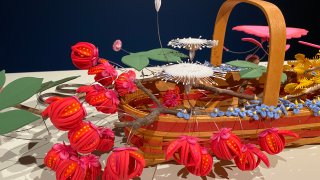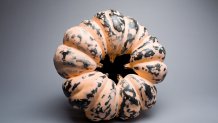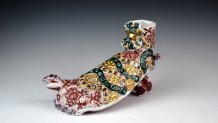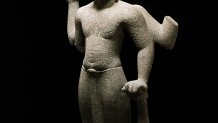
Out of the darkness of the coronavirus pandemic, Kana Harada creates a garden of art blossoming with hope, peace, and light. Divine Spark, Harada’s first solo at the Crow Museum of Asian Art of The University of Texas at Dallas, is now on view at the museum’s Dallas Arts District campus through September 5.
Divine Spark is the second of the museum’s multi-year Texas Asian Women Artists exhibition series. Harada was born in Tokyo and currently lives and works in Dallas. “A lot of the works that are being presented in this series are not only focused on celebrating and highlighting the work of these incredible artists but also speaking to the times in some way,” Jacqueline Chao, the museum’s senior curator of Asian art, said. “Many of these works you see here were created by Kana during the time of pandemic.”

The name of the exhibition is derived from a piece in the exhibition Harada created in 2020. The foam sheet and mixed media piece is representative of her artistic soul. “It is here I always find strength to really believe in myself no matter what and it is the source of infinite imagination,” Harada said.
Get top local stories in DFW delivered to you every morning. Sign up for NBC DFW's News Headlines newsletter.
The works in the exhibition are nature-inspired black foam sculptures, delicately cut paper creations, vivid acrylic and watercolor paintings, reflecting a resolute optimism. “My art has always been about a sense of peace and calmness and expressing joy and gratitude towards having been given life. When the pandemic started, it didn’t take me long to realize it was a sense of mission or purpose to really deliver more than ever a sense of peace because that’s what I wanted for all of us all around the world,” Harada said.
Harada’s inspiration for her pandemic work springs from her compassion for others. “The personal heartbreaking stories after story after story after story. It made me even more laser-focused, determined to do my part through my art,” Harada said.

With works named Fearless Hope, Freshly Picked, Home Sweet Home, Love Letter from the Future, Ingrained and Moon Kissed, the exhibition is a dreamy garden at night. “We wanted to play with this idea of inside and outside, being inside but creating this feeling of being outside,” Chao said.
Benches and stools are scattered through the exhibition, inviting visitors to sit, find peace and notice the intricate details of Harada’s works. “I’ve always found that sitting makes me feel more relaxed and want to take in what’s there,” Harada said.

Divine Spark complements Born of Fire: Contemporary Japanese Women Ceramic Artists. The exhibition in the mezzanine gallery of the museum features a selection of works by living Japanese ceramic artists. The works are drawn from the collection of Carol and Jeffrey Horvitz. Their encyclopedic collection of more than 1,000 works is the largest public or private assemblage of contemporary Japanese ceramics outside of Japan.
Nature inspired these ceramists. Katsumata Chieko’s untitled piece resembles a pumpkin and reveals her innovative technique. “What she does is create these organic forms at first but then instead of painting directly on the surface of the vessel, she uses this thin, gauzy material and she pushes the paint or glaze through that,” Chao said. “It just looks like an effortless pattern.”

One artist’s name shows a shift in Japanese society. Traditionally, a father passes his artistic trade to his son. Tokuda Yasokichi III did not have a son. Instead, his daughter became Tokuda Yasokichi IV and continued to work with vibrant colors. “She took on his name, which is very unusual,” Chao said. “But she has her own style. She chooses colors her father may not have chosen.”
Matsuda Yuriko’s In Her Shoes sits near a staircase and transforms the ordinary into something whimsical. “She likes playing with body parts in her works as well as with forms from everyday life like fruits and vegetables,” Chao said. “She also plays with different colorful glazes and she also uses the Japanese technique of gold brocade known as kinrade, which you can see in this gold patterning on the foot. A very elegant piece, a very fun piece.”

Also on view is Vishnu: Across Time and Space. Drawn from the museum’s collection, the exhibition focuses on Vishnu, one of the most powerful gods in the Hindu pantheon. The exhibition shows how the artistic and visual representations of Vishnu has evolved over time and how the god can look different depending on the context.

Learn more about the three exhibitions: https://crowcollection.org/

